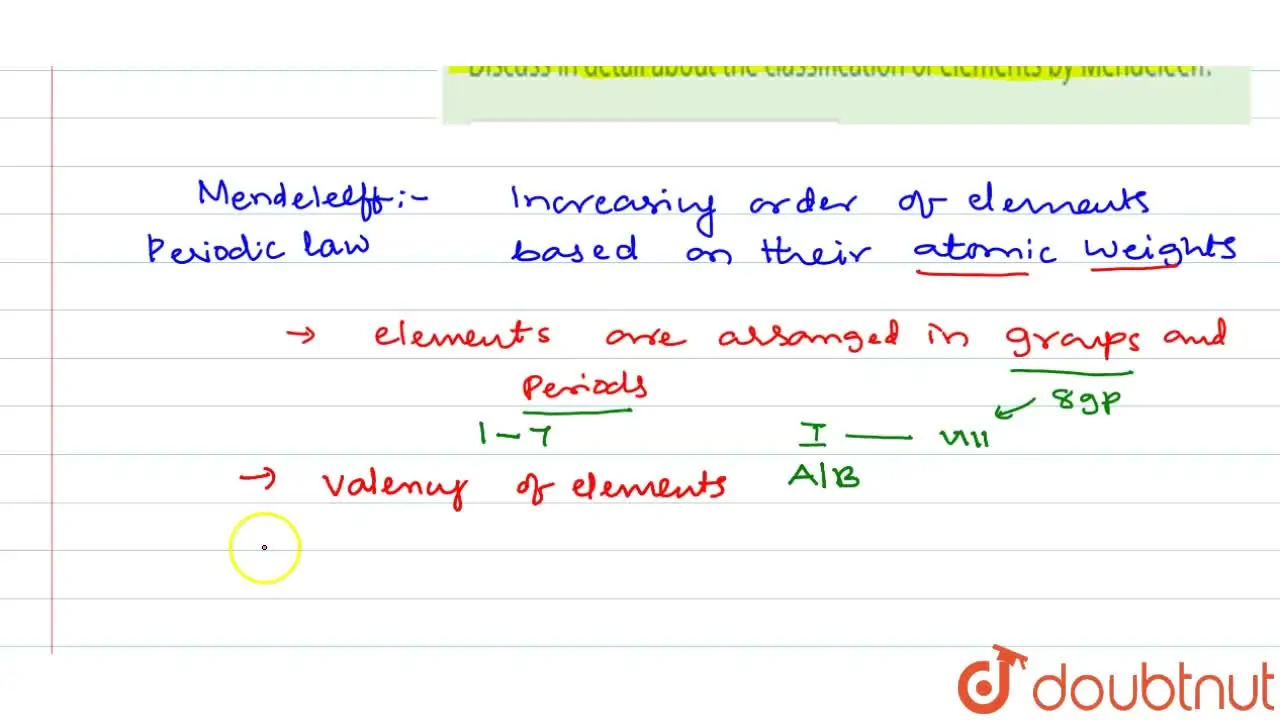Discuss in detail about the classification of elements by Mendeleeff.Solution in Telugu
The periodic classification of elements based on ..atomic weights.. was done by ..Lothar Meyer.. and ..Mendeleev.. independently.
Mendeleev.s periodic law: The physical and chemical properties of elements and their compounds are a periodic function of their atomic weights.
Mendeleev arranged the 65 elements in a periodic table. He did not blindly follow the atomic weight but gave more importance to their chemical properties in arranging them in the table. Explanation of the periodic law: When the elements are arranged in the increasing order of their atomic weights, elements with similar properties appear again and again, at regular intervals. This is called, periodicity of properties.
Mendeleev.s table: Mendeleev introduced a periodic table containing the known 65 elements. In this table, while arranging the elements, he gave importance only to their atomic weights, but also to their physical and chemical properties. This table was defective in some responses. Then he introduced another table, after rectifying the defects of that table. It is called ..short form of periodic table... He named the horizontal rows as periods and the vertical columns, as .groups.. It has in all .9. groups, I to VIII and a .O. group. The first .7. groups were divided into A and B sub groups. There are .7. periods in the table. The VIII group contains three triods, namely (Fe, Co, Ni), (Ru, Rh,Pd) and (Os, Ir, Pt).
Mendeleev.s observations: (1) When the elements are arranged according to their atomic weights, they exhibit periodicity of properties.
(2) Elements with similar chemical properties have nearly equal atomic weights: Iron (55.85), Cobalt (58.94) and Nickel (58.69).
(3) The group number corresponds to the valency of element in that group.
(4) Most widely distributed elements like H, C, O, N, Si, S etc. have relatively low atomic weights.
(5) The atomic weight of an element may be corrected if the atomic weights of the adjacent elements are known. The properties of an element are the average properties of the neighbouring elements.
(6) The atomic weights of beryllium, Indium, Uranium etc. were corrected, based on this observation.
Merits of Mendeleev.s table:
(1) Actually it formed the basis for the development of other modern periodic tables.
(2) Mendeleeffs left some vacant spaces in his periodic table, for the unknown elements. But the predicted the properties of those element. Later on, when these elements were discovered, they exactly fitted into those vacant places having properties, predicted by Mendeleev.
Ex: Eka- boron (Scandium), EKa-Silicon (germanium)
EKa− aluminium (gallium) etc.
(3) .O. group elements were not known at the time of Mendeleeff. Later when they were discovered, they found a proper place in that table under .0.. group of elements. Similarly, the radioactive elements.
(4) In case of these pairs of elements Tellurium -iodine Argon-Potassium and Cobalt-Nickel, there is a reversal of the trend. The first element has higher atomic weight than the second one. These are called anomalous pairs. However, based on their atomic numbers, and chemical properties, this arrangement proves quite justified.
Draw backs of Mendeleev.s periodic table:
(1) Dissimilar elements were placed in the same group. Ex: The coinage mentals Cu, Ag and Au are placed along with the alkalimetals K, Rb, Cs etc. in the I group. The only common property among them is that they are all univalent (Valency=1).
(2) The 14 rare earths having different atomic weights are kept in the same place.
(3) Hydrogen could not be given a proper place, as it resembles alkali metals and halogens in its properties.
Related Playlists
- BOOK - VIKRAM PUBLICATION ( ANDHRA PUBLICATION)CHAPTER - CLASSIFICATION OF ELEMENTS AND PERIODICITY IN PROPERTIESEXERCISE - Short Answer Questions38videos
CLASSIFICATION OF ELEMENTS AND PERIODICITY IN PROPERTIES
- BOOK - VIKRAM PUBLICATION ( ANDHRA PUBLICATION)CHAPTER - CHEMICAL EQUILIBRIUM AND ACIDS BASES EXERCISE - LONG ANSWER QUESTIONS31videos
CHEMICAL EQUILIBRIUM AND ACIDS BASES
- BOOK - VIKRAM PUBLICATION ( ANDHRA PUBLICATION)CHAPTER - ENVIRONMENTAL CHEMISTRYEXERCISE - LONG ANSWER QUESTIONS6videos
ENVIRONMENTAL CHEMISTRY
Similar Questions
On the basis of quantum numbers, justify that the 6th period of the periodic table should have 32 elements.
00:41View SolutionWhat are equilibrium processes? Explain equilibrium in Physical and Chemical processes with examples.
10:10View SolutionWhat is environmental pollution? How many types of pollution are encountered?
06:41View Solution__________ was the basis of the classifications proposed By Dobereiner , Newlands and Mendeleeff .
05:47View SolutionDiscuss in detail about the conformations exhibited by ethane.
01:09View SolutionDiscuss in detail about the general methods of preparation of alkenes.
03:25View SolutionExplain in detail about systematic errors and its classification.
02:20View SolutionDiscuss in detail about the Bacterial Chromosome.
View SolutionExplain the mode of nutrition in bacteria.
View SolutionDiscuss in detail about the classification of elements by Mendeleeff.
View SolutionExplain in detail about the classification of energy resources.
50:09View SolutionDiscuss in detail about the emergence of cathedrals.
07:46View SolutionDiscuss in details about the places of residence of early humans.
02:20View SolutionPeriodic Classification Of Elements |NCERT Questions Discussion
40:58View SolutionDiscuss in detail about the classification of elements by Mendeleeff,
52:13View SolutionDiscuss in detail about the classification of elements by Mendeleeff.
05:04View Solution


